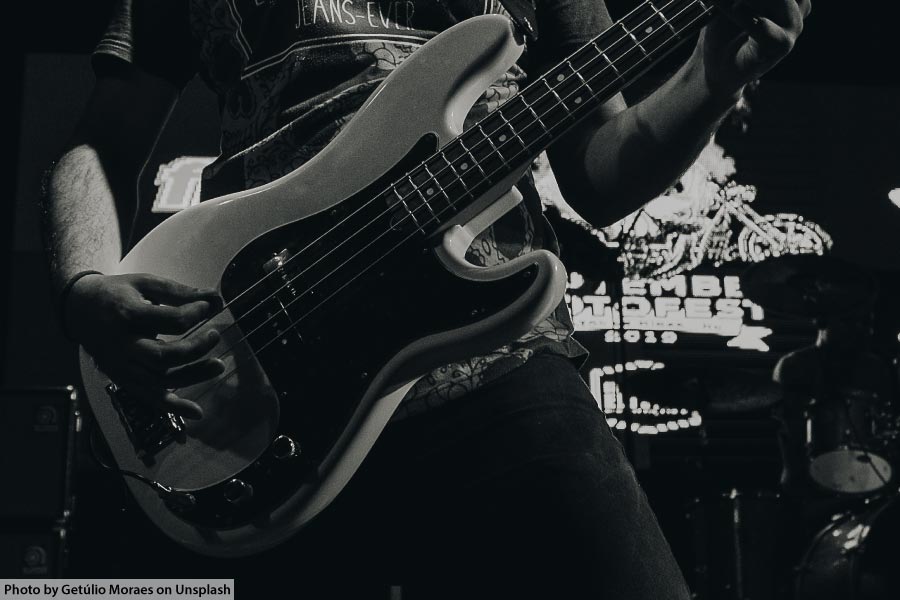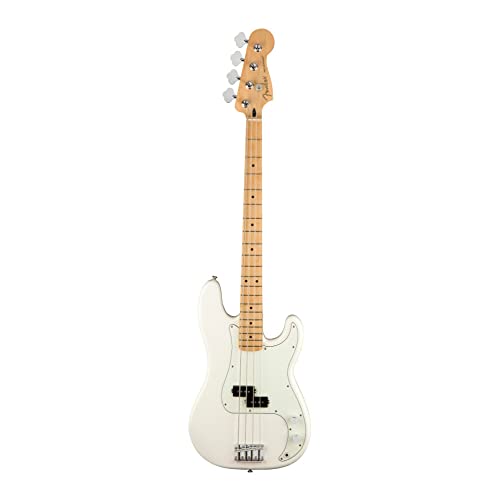What Is the Best Bass for Metal? What makes a good metal bass? On this page we identify that features you should look out for in a metal bass, and suggest specific basses for you to check out!
Best Bass For Metal: Three Basses To Check Out (See More Suggestions Further Down The Page)
Schecter Stiletto Stealth
- 4-string Electric Bass with Basswood Body
- Active 2-b EQ - Satin Black
- Rosewood Fingerboard
- Maple Neck
- 2 Pickups
Schecter have earned themselves a reputation as metal mainstays with their radical shapes and precision engineering. The Stiletto Stealth bass is no exception to this rule, with its sinister satin black finish and powerful, rumbling tone.
Schecter are a very popular brand among metal musicians who appreciate the brand’s balance of edgy aesthetics (both literally and figuratively - look at that menacing design!), phenomenal tones, and aggressive price points. This mid-range bass offers great bang for your buck, and will catch the attention of anyone in attendance at your next gig.
The Stiletto Stealth model comes in both four- and five-string versions. It’s well-suited to a variety of metal subgenres, so if you’re looking to dip your toe in the water, so to speak, then this might just be the bass for you. You can even split the coils in the Stiletto’s active humbucker, so you can access both meaty humbucking tones and more articulate single-coil sounds.
See price / reviews at AmazonIbanez SR305E
- 2 Humbucking Pickups - Cerulean Aura Burst
- 5-string Electric Bass with Mahogany Body
- Jatoba Fingerboard
- Maple/Walnut Neck
This fantastic five-string covers just about all the bases (no pun intended) for the budding metal bass player. Dual humbucking pickups and a mahogany body deliver plenty of power and punch in the tone, and the maple/walnut neck gives this bass quite a bit of snap and definition.
Ibanez are one of the market leaders in producing instruments for metal players, and this excellent bass guitar is no exception to that rule. It’s a great price, too, retailing at under $400.00.
This bass has phenomenal playability and, with its extended, 5-string range, will appeal to players looking at the technique-heavy metal subgenres. It’s nice and versatile, and it sounds just as good as it plays. A great metal bass for your first step into heavier music, or as a backup bass for a pro who needs reliability above all else.
See price / reviews at AmazonFender Precision Bass
- Alder Body with gloss finish
- One player Series split-coil precision bass middle pickup
- Master volume and tone controls
- “Modern C"-Shaped neck profile
- 9. 5"-Radius Fingerboard
A Fender Precision Bass is a solid choice whatever style of music you want to play, and this classic instrument makes an excellent bass for metal. Countless metal bassists have wielded a P-bass both onstage and in the studio. Steve Harris of Iron Maiden is probably the bass’s best-known proponent, and there are many more.
Fender's "Player" range of guitars and basses are made in Mexico and represent an excellent halfway-house between their Squier range and the more expensive, American-made instruments.
See price / reviews at AmazonYou can see more recommended metal basses further down the page.
What Makes A Bass Good for Metal?

Metal might be the most varied genre of music. With myriad subgenres, from the classic hard rock of early Sabbath to the crushing edge-of-noise prog of Meshuggah, there are plenty of different types of metal music you could be playing.
A bass that is suited to highly-technical progressive metal might not work as well for old-school thrash, and vice versa.
Generally speaking, however, the features of a great instrument apply across the board: tone; playability; aesthetics; looking cool when you play the instrument on stage. These are all worthy considerations when looking to buy a bass for metal.
These days, you can find bass guitars with four, five, six, or even twelve strings. For most players, five bass strings is more than enough. We’d recommend looking at either four- or five-string basses, as you’ll see from the list below.
For beginners, we suggest getting a four-string bass before making the leap to an instrument with five (or more) strings.
Playability
First and foremost, you want your bass to be easy to play. Metal can be one of the most technically demanding styles of music to play. Accordingly, slender, comfortable necks and relatively low action for your bass strings are important when choosing a metal bass guitar.
Most players find the broader necks of extended-range basses difficult to play, at least when they’re starting out. If you’re playing metal for the first time, you’ll want to start on a bass with four or, at most, five strings, and work out based on your musical preferences if you need more.
Pickups
Another factor is the choice of pickups in your bass. Most basses aimed at metal players will have high-output active pickups. These provide more power, more distortion, and more grunt than the passive pickups you’ll find in other basses such as the Fender P-bass.
Body Material
The wood from which your bass is made will be another thing worth considering. Basswood and alder are nice and light, which is a key consideration when you’re looking at standing up with the bass across your shoulders for an hour or two on stage.
These lighter woods typically provide more articulation and snap for your tone, while heavier, denser woods like mahogany often have a darker, fatter sound.
Bass guitars can also be very heavy. Some basses are built using dense, deep woods like mahogany. Metal musicians still spend much of their time playing live, so if you prefer a lighter weight around your shoulders while shredding, you should consider the woods used in making your bass. Generally, mahogany instruments are heavier, while basswood and alder basses tend to be lighter.
Shape
Last, but certainly not least, is the body shape of your bass. While sound and playability are paramount, if you plan on delivering crushing riffs live, you want the look of your bass to match the brutality of your music.
You don’t necessarily have to wield an axe-shaped bass like Gene Simmons, but metal basses often boast radical shapes. Points, spikes, and aggressive finishes are par for the course with many metal basses.
Be careful to “audition” a bass with a non-standard body shape thoroughly. The “standard” bass guitar shape evolved for a reason; you might find that the balance and/or playability of a metal bass has been compromised for the sake of style.
With that being said, metal is a visceral art form, and image is important! Buy a bass based on what is important to you and get playing!
Best Bass For Metal: More Good Metal Basses To Check Out
There are plenty of great bass guitars out there for any budding metal musicians. Here are some of our top picks:
Rickenbacker 4003
The entry of the Rickenbacker 4003 into the pantheon of metal basses needs only three words:
Lemmy played one.
The bass of choice for Motorhead’s iconic frontman, one of the most influential figures of the heavy metal movement, is a great instrument. The Rickenbacker’s silhouette stands out immediately, and its shorter scale and four strings are well-suited to speedier styles of music. Think thrash, speed metal, or uptempo 80s power metal.
The treble-heavy sound of the Rickenbacker 4003 also neatly lends itself to heavy pedal usage, and it sounds great with a snarling fuzz pedal in the signal chain. This is not a bass guitar for downtuning and sluggish riffs, but for fuzzy stoner metal and classic stylings, it’s hard to look past this iconic instrument.
See price / reviews at AmazonESP LTD F-204
ESP are a well-established Japanese brand with a solid foothold in the world of heavy metal instruments. Apart from designing guitars for Metallica’s James Hetfield and Kirk Hammett, ESP also produce great metal basses.
The F-204 boasts an extreme design with plenty of jagged edges and sharp contours. With four strings, maple-and-mahogany construction, and an active three-band EQ for its twin humbucking pickups, this bass is built to rock.
This bass’s mahogany body makes it one of the heaviest - both by mass and by tone - instruments on our list. The star of the show here is the F204’s set of Fishman Fluence humbuckers, which have a distinctive character that will help your bass stand out in the mix, especially in a live setting.
See price / reviews at AmazonWarwick Rockbass Corvette
- 4-string Electric Bass with Alder Body
- 2 Single-coil Pickups - Natural
- Wenge Fingerboard
- Maple Neck
Warwick’s Rockbass Corvette takes a few design cues from Fender’s bass guitars, with its alder body and maple neck. Its radical shape and powerful tone, however, will leave players in no doubt that this is a serious instrument for metal players.
The plain-wood finish might not be for everyone, but metal isn’t exactly the most mainstream music there is. The pair of active humbuckers on this bass give it all the oomph and grunt you could want from a metal bass guitar.
With four strings, it’s definitely aimed more at traditionalist players. This is a great bass for playing classic thrash or traditional metal. It’s more Megadeth than Meshuggah, more Dio than Djent.
See price / reviews at AmazonCharvel Pro Mod San Dimas PJ
- 4-string Electric Bass with Alder Body
- Active Electronics - Mystic Blue
- 2 Single-coil Pickups
- Maple Fingerboard
- Maple Neck
Californian builders Charvel have been hot-rodding Fender designs for decades now. The Heavy metal mainstays like Iron Maiden’s Steve Harris wielded Fender bass guitars for decades, and this Charvel PJ nods its head to several of Fender’s design cues while retaining a character well suited to extreme music. It looks like a P bass, but has two pickups, like a J bass.
An alder body and caramelized maple neck - not to mention the gorgeous Mystic Blue sparkling finish - make this a lightweight, highly playable guitar with looks that kill. With four strings and a sparkling finish, this is better suited to flashier, vintage-styled metal than to cutting-edge screaming black metal.
See price / reviews at AmazonEpiphone Thunderbird
- 34” scale, a 12” radius, and 20 medium jumbo frets
- vintage styled 60s Tune-o-matic bridge
- Claw tailpiece
Epiphone’s Thunderbird is a scaled-back version of the iconic Gibson Thunderbird. Gibson’s bass guitar boasted neck-through-body construction and an authoritative, assertive growling tone.
This Thunderbird’s neck also runs through the body, with two mahogany “wings” attached to produce the iconic Thunderbird silhouette. With powerful Epiphone ProBucker pickups in both the neck and bridge positions, and a comfortable rounded 1960s-style neck profile, this is a great bass for gigs and studio work alike.
If you like a bit of growl and grit for your bass tone, the Epiphone Thunderbird offers that in spades. Be aware that these basses, with their long, heavy necks, tend to suffer from “neck dive”, overbalancing in the direction of the headstock when dangling from your shoulders. They’re also pretty heavy, so if you have a slighter frame, a bass made from lightweight basswood might suit you better than this all-mahogany beast.
See price / reviews at AmazonBest Metal Bassists Of All Time – A List, With Hand-Picked Videos and Recommended Albums
Types Of Bass Guitar: Which Is Best For You?
Best Guitars For Metal: Features You Need, Recommended Brands & Models
Best Bass Players List: The Best Bassists Of All Time










